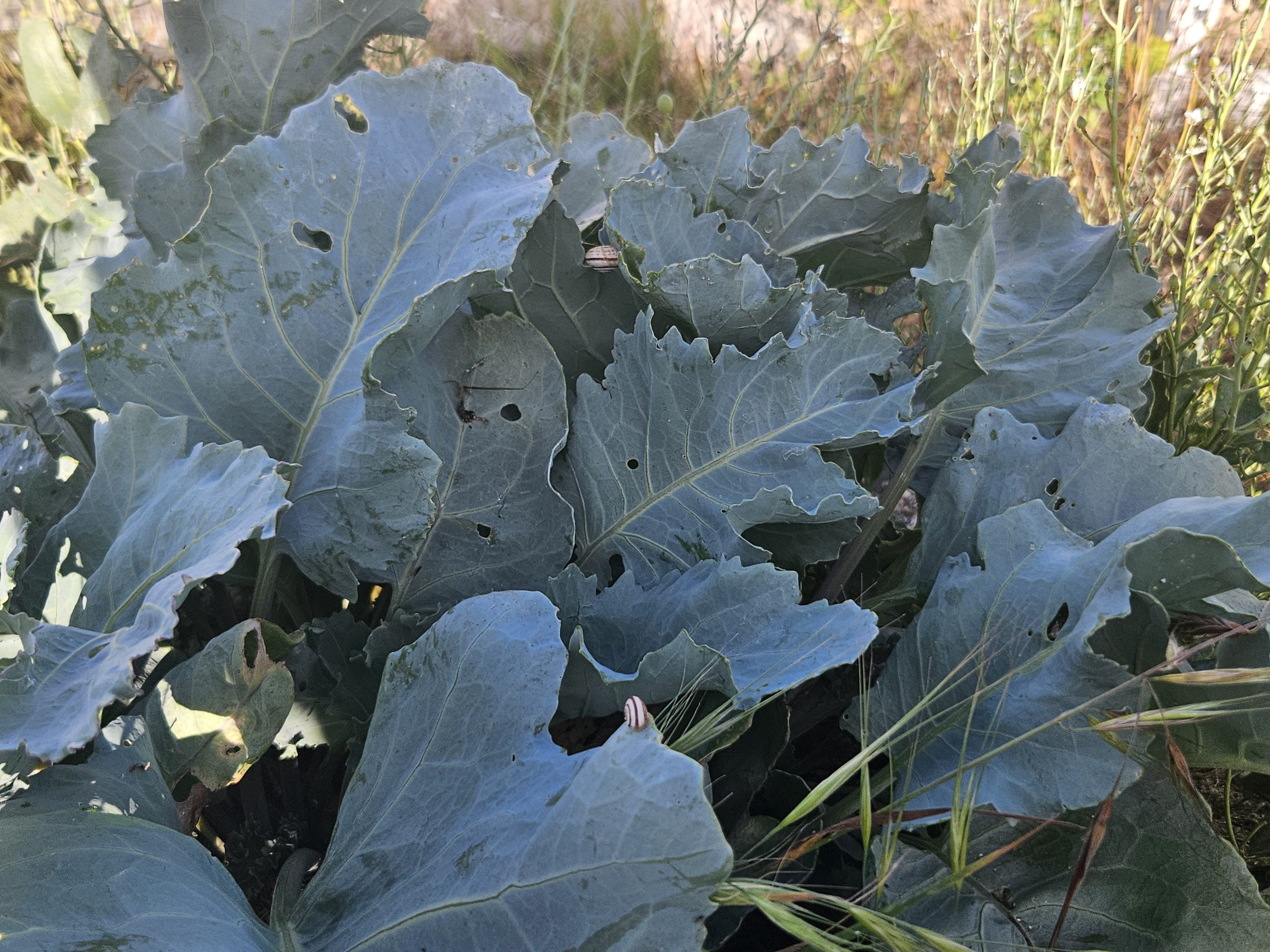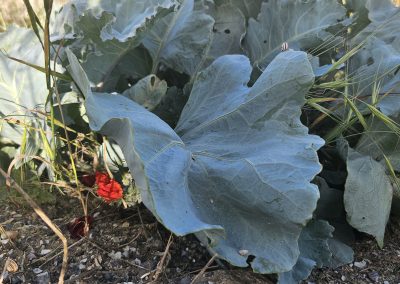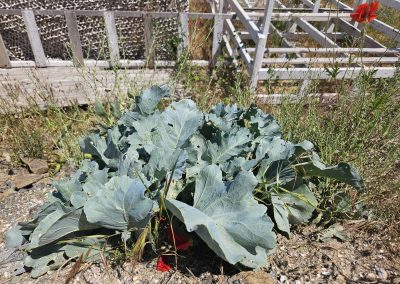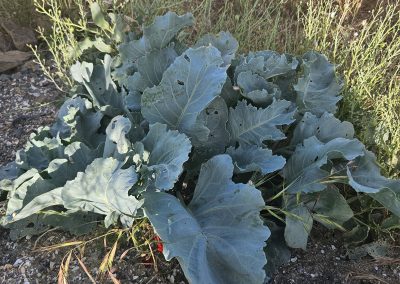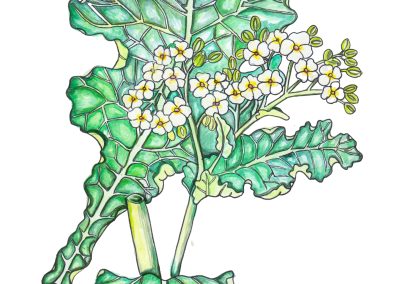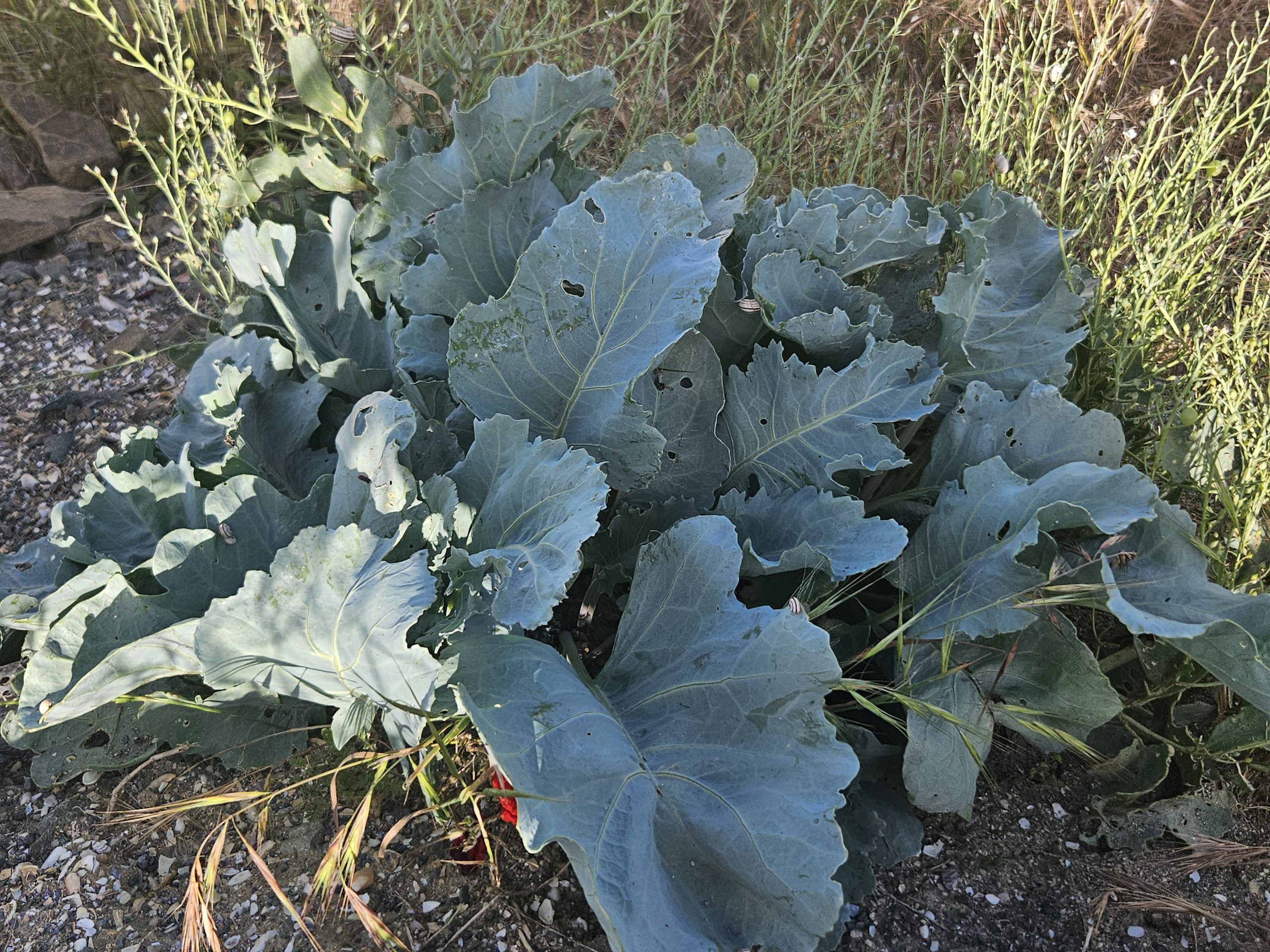Crambe maritima
Scientific description
Taxon: Angiospermatophyta (Magnoliophyta)
Class: Dicotyledonatae (Magnoliatae)
Subclass: Dileniidae
Order: Cruciferales
Family: Cruciferae (Brassicaceae)
Common name: Sea Kale
Origin: European, specific to the coastal zone
Description:
It is a herbaceous plant, growing up to 75cm tall, with a diameter of 60cm and large, fleshy leaves. The flowers are white and abundant. The pods are globular and contain a single seed. The fruit is a silicle consisting of two unequal parts, a small lower part and a larger upper part where a viable seed is located.
Propagation: Seeds
Ecology:
It grows in ruderal places, on uncultivated land, on plains and hills. It thrives in sunny and very dry areas, on sandy and halophytic soils.
Use:
Used as an ornamental plant in parks and gardens to create rockeries and sandy areas. In some countries, the sprouts are consumed as food.
Threat: It is a vulnerable and rare halophytic plant.
Încrengătura: Angiospermatophyta (Magnoliophyta)
Clasa: Dicotyledonatae (Magnoliatae)
Subclasa: Dileniidae
Ordinul: Cruciferales
Familia: Cruciferae (Brassicaceae)
Denumire populară: varza de mare
Originea: europeană, specifică zonei litorale
Descrierea:
Este o plantă ierboasă, crește până la 75cm, cu un diametru de 60cm. Are frunze mari cărnoase. Florile sunt albe și abundente. Păstăile sunt globulare și conțin o singură sămânță.
Înmulțire: Semințe
Ecologie:
Crește în locuri ruderale, pe terenuri necultivate, din zona de câmpie și deal. Vegetează foarte bine în zonele puternic însorite și foarte uscate, pe nisipuri și soluri halofite.
Utilizare:
Este întâlnită și ca plantă ornamentală, în parcuri și grădini pentru a realiza stâncării și zone de nisip. În unele țări se consumă și alimentar, consumându-se lăstarii.
Pericol: Este o plantă halofită, vulnerabilă, rară.
Γένος: Angiospermatophyta (Magnoliophyta)
Τάξη: Magnoliatae (Magnoliatae)
Υποκατηγορία: Dileniidae
Τάξη: Cruciferales
Οικογένεια: Cruciferae (Brassicaceae)
Δημοφιλές όνομα: θαλάσσιο λάχανο
Καταγωγή: Ευρωπαϊκό, ειδικά για παράκτιες περιοχές
Περιγραφή:
Είναι ποώδες φυτό, φτάνει τα 75 εκατοστά, με διάμετρο 60 εκατοστά. Έχει μεγάλα σαρκώδη φύλλα. Τα άνθη του είναι λευκά και άφθονα. Οι λοβοί είναι σφαιρικοί και περιέχουν έναν μόνο σπόρο.
Πολλαπλασιασμός: Σπόροι
Οικολογία:
Αναπτύσσεται σε αγροτικές, ακαλλιέργητες, πεδινές και λοφώδεις περιοχές. Ευδοκιμεί καλά σε πολύ ηλιόλουστες και ξηρές περιοχές, σε αμμώδη και αλοφυτικά εδάφη.
Χρήση:
Είναι επίσης συνηθισμένο ως καλλωπιστικό φυτό σε πάρκα και κήπους για τη δημιουργία βράχων και αμμωδών περιοχών. Σε ορισμένες χώρες τρώγεται επίσης για τροφή, με τους βλαστούς να τρώγονται.
Κίνδυνος: Είναι ένα σπάνιο, ευάλωτο, αλοφυτικό φυτό.
Taxon / Espèce : Angiospermatophyta (Magnoliophyta)
Classe : Dicotylédones (Magnoliatae)
Sous-classe : Dileniidae
Ordre : Crucifères
Famille : Crucifères (Brassicacées)
Nom commun : Chou marin
Origine : Européenne, spécifique à la zone côtière
Description :
C'est une plante herbacée, pouvant atteindre 75 cm de haut, avec un diamètre de 60 cm et de grandes feuilles charnues. Les fleurs sont blanches et abondantes. Les gousses sont globuleuses et contiennent une seule graine. Le fruit est une silicule composée de deux parties inégales, une petite partie inférieure et une partie supérieure plus grande où se trouve une graine viable.
Propagation : Graines
Écologie :
Elle pousse dans les endroits rudéraux, sur les terres non cultivées, dans les plaines et les collines. Elle prospère dans les zones ensoleillées et très sèches, sur des sols sablonneux et halophytiques.
Utilisation :
Utilisée comme plante ornementale dans les parcs et les jardins pour créer des rocailles et des zones sablonneuses. Dans certains pays, les pousses sont consommées comme nourriture.
Menace : Il s'agit d'une plante halophytique vulnérable et rare.
Creative writing inspired by Crambe maritima
Written by Scupra Cristian
The Myth of The Sea Cabbage
In the time before time, when the world was young and the seas teemed with mysteries, there existed a humble cabbage farmer named Orlan. Orlan lived by the rugged coast, where the salty winds danced with the waves, and the sun painted the horizon with its golden hues each evening.
One stormy night, as Orlan tended to his crops, a mighty tempest descended upon the land. The thunder roared like an angry giant, and the waves crashed against the cliffs with relentless fury. In the chaos of the storm, a peculiar sight caught Orlan's eye—a lone cabbage, tumbling through the tumultuous waters, carried by the furious winds of the tempest.
Driven by a curious impulse, Orlan braved the raging storm and waded into the churning sea to rescue the wayward cabbage. With each step, the waves threatened to swallow him whole, but Orlan pressed on, guided by an inexplicable sense of purpose.
Finally, he reached the cabbage and cradled it in his arms, shielding it from the wrath of the storm. As if touched by a divine hand, the cabbage began to glow with a soft, ethereal light, illuminating the darkness of the tempest. In that moment, Orlan felt a surge of power coursing through his veins, as if the very essence of the sea itself flowed within him.
When the storm subsided and Orlan returned to shore, he planted the mysterious cabbage in his fields, unaware of the extraordinary gift he had discovered. To his amazement, the cabbage flourished like none other, yielding a bountiful harvest that sustained his village for generations to come.
Word of Orlan's miraculous cabbage spread far and wide, and soon, people from distant lands came to witness its wonder. They called it the "Sea Cabbage," believing it to possess mystical properties that could heal the body and calm the waters of the soul.
And so, the legend of the Sea Cabbage was born—a testament to the resilience of the human spirit and the boundless mysteries of the sea. To this day, sailors and travelers seek out the shores where Orlan's cabbage first washed ashore, hoping to catch a glimpse of its mystical glow and partake in its miraculous bounty.


